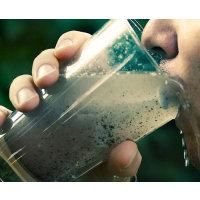California Inching Toward a Tougher Standard on Rocket Fuel in Drinking Water

The U.S. Environmental Protection Agency (EPA) put the chemical perchlorate, prominently known for its use in rocket fuel and striking presence in the environment, on its “Contaminant Candidate List” (pdf) in 1998.
An EPA draft risk assessment determined that 1 part per billion (ppb) should be considered safe for perchlorate, but that didn’t go anywhere during the Bush years.
So, one year after Massachusetts, California set its own standard in 2007 for how much perchlorate would be allowed in drinking water. No other state followed their lead and there is no national standard, although the toxic chemical has been strongly linked to thyroid problems in pregnant women and young children. A study released last November found that women with high doses of perchlorate had babies with lower IQs.
The EPA agreed in 2011 to set a standard in 2013, but is still working on it.
California’s standard of 6 parts per billion was three times the Massachusetts standard, and almost immediately after its posting, work began on making it tougher. The state Office of Environmental Health Hazard Assessment (OEHHA) circulated a draft proposal for 1 part per billion in 2012 and last week released it as a final public health goal (PHG).
It’s a goal, not a rule.
The State Water Resources Control Board (SWRCB) has until March 2016 to decide if it wants to adopt 1 ppb as a standard. Lowering the standard would cost a lot of cleanup money and eliminate some resources.
The EPA says on its website that perchlorate has been found in 350 of 6,400 water wells in California, although it’s hard to tell how dated the information is:
“Contamination of groundwater and of the Colorado River affects important drinking water and irrigation water supplies. There may be over 30 sites with perchlorate in California alone. Thirteen of these are EPA Superfund sites and the state of California leads cleanup efforts at twelve other sites. . . . The discovery of perchlorate at sites where cleanups were already underway has both delayed those cleanups and added substantial costs over initial projections.”
Perchlorate is primarily associated with propellants. In addition to rocket fuel, it is used in the manufacture of fireworks, missiles, explosives and flares. The chemical also naturally occurs in some fertilizers.
Residents in the city of Rialto paid a $9-a-month “perchlorate surcharge” on their water bills from 2004-2012 to cover the cost of dealing with polluters who contaminated the local groundwater. Last year, the last in a long line of parties involved in litigation over decades of chemical dumping—testers and manufacturers of munitions, rocket motors and fireworks—settled (pdf) a lawsuit brought by the nearby city of Colton but argued by the U.S. Department of Justice.
–Ken Broder
To Learn More:
California Lowers Health Goal for Perchlorate (by Jim Steinberg, San Bernardino Sun)
Water Contaminant Linked to Children's Low IQs (by Brian Bienkowski, Environmental Health News)
One of Riverhead Water District’s Newest Wells Offline, Needs Costly System to Remove Contaminant Perchlorate (by Denise Civiletti, Riverhead Local)
What Do Rocket Fuel and Baby Formula Have in Common? (by Adrine Akopyan, AllGov)
$11 Million Payout for the “Rockets, Fireworks, and Flares Superfund” (by Ken Broder, AllGov California)
Final Technical Support Document on the Public Health Goal for: Perchlorate in Drinking Water (Office of Environmental Health Hazard Assessment)
Perchlorate in the Pacific Southwest (U.S. Environmental Protection Agency)
- Top Stories
- Controversies
- Where is the Money Going?
- California and the Nation
- Appointments and Resignations
- Unusual News
- Latest News
- California Forbids U.S. Immigration Agents from Pretending to be Police
- California Lawmakers Urged to Strip “Self-Dealing” Tax Board of Its Duties
- Big Oil’s Grip on California
- Santa Cruz Police See Homeland Security Betrayal in Use of Gang Roundup as Cover for Immigration Raid
- Oil Companies Face Deadline to Stop Polluting California Groundwater





